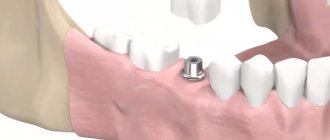Why does numbness in the upper or lower jaw persist after implant installation?
Often, after placing an implant, temporary complications arise in the form of loss of sensitivity, aching pain, bleeding and redness of the gums, swelling - all this is a normal reaction to surgery. Usually paresthesia goes away without a trace after 3-5 hours, all other symptoms - after 4-6 days.
There is no need to delay a visit to the doctor if numbness lasts more than five hours . It can occur either due to the effect of anesthesia or due to:
- poor preparation for surgery, incorrect selection of implants, the site of their integration;
- injuries of the mandibular trigeminal nerve.
Get a consultation
We will answer all your questions before visiting the clinic!
+7
Online registration
Content
1 Main types of complications after dental implantation 1.1 Pain after implant installation
1.2 Swelling after installation of an artificial tooth
1.3 Temperature rise
1.4 Feeling numb
1.5 Seam separation
1.6 Inflammation in the implant area
2 Rejection of an artificial tooth
Anesthesia during surgery
Numbness prevents you from feeling pain during surgery. Achieved by administering anesthetic drugs. If sensitivity returns and the procedure has not yet come to an end, the drug is added to prolong the effect of local anesthesia.
In rare cases, a substance used for pain relief or improperly administered anesthesia can cause longer-term numbness - up to six months.
Pros of dental implantation
As we have already said, implantation has not only disadvantages, but also very significant advantages. In many cases, they outweigh the disadvantages of dental implants; in addition, there are situations when implantation is the only way out - for example, when a denture causes a gag reflex, or in the case of the loss of all teeth, when there is no other support for the orthopedic structure.
Aesthetics
This is the first most important advantage: artificial teeth on implants cannot be distinguished from natural ones by their appearance, while dentures are often noticeable to a careful eye.
Naturalness of sensations
After implantation, artificial teeth are no different from your own - you don’t even need to get used to them, because... they completely reproduce the shape and function of natural teeth. It will take much longer to get used to dentures, and some people cannot get used to them completely.
Natural gum contour
The gum former restores its original shape and subsequently the gum contour completely coincides with the natural one, in contrast to prostheses, which constantly act on the gum, changing its shape.
Stopping bone atrophy
When a tooth is lost, the chewing load that it exerted on the jaw bone disappears, and this entails atrophy (resorption) of the bone tissue, which sooner or later will affect the neighboring teeth, leading to their displacement and loosening. The implant transfers normal load to the bone, just like a regular tooth, so atrophy does not occur and the neighboring teeth are not in danger.
Hassle-free power supply
Dietary restrictions are set only for the period immediately after implantation - until the artificial root takes root completely. After this, the implants are no different in their functions from natural ones, so they can chew any food, even hard ones. The implants will not suffer from this and will not fall out like dentures.
Preservation of adjacent teeth
A typical case of prosthetics is the grinding of adjacent teeth on which the prosthesis rests. This leads to their gradual wear and subsequent loss. The implant does not require treatment of adjacent teeth and allows you to save them completely.
Durability
All leading manufacturers provide a lifetime warranty on their implants. This means they will last for many years. Only the crown will need to be replaced approximately once every 10 years as it wears out. The implant itself will last for the rest of your life. And if something happens to it, the manufacturer provides a free replacement.
Full functionality
It is not always possible to fit dentures well so that they do not spoil diction or interfere with chewing food. There is no such problem with implants. They fully reproduce aesthetics, diction, and chewing function without any restrictions. And in case of complete loss of teeth, a denture on implants is the only alternative to constantly falling out false jaws.
Prevention
By preventing bone tissue atrophy and preventing the displacement and loosening of neighboring teeth, implants prevent the development of damage to their roots - periodontal disease.
We looked at the pros and cons of dental implants in general and, as we see, in some cases there is simply no alternative to installing implants. At the same time, the most important thing for the patient is not to choose certain models or manufacturers, but to choose a good doctor. Because implants from all leading manufacturers provide the same highest level of quality, but doctors have different abilities and experience.
At the Dental Master clinic you will find an experienced team of doctors with extensive knowledge and qualifications to carry out any type of implantation. An implantologist will select the most suitable material for your case, plan all stages of treatment, carry out the necessary diagnostics and install implants, with which you will not have any problems.
Numbness from damage to the mandibular nerve
Symptoms
The following signs may indicate that the trigeminal nerve of the lower jaw is damaged during tooth implantation:
- prolonged numbness, which is accompanied by slight tingling;
- violation of facial expressions;
- difficulty swallowing;
- Difficulties in hygiene;
- painful sensations;
- increased salivation.
Sometimes nasal congestion may occur. The listed symptoms should be a reason to urgently consult a doctor.
Why is this happening?
The trigeminal nerve may be damaged during dental implantation under the following circumstances:
- injured by a needle during the administration of anesthesia;
- pressed by an implant that is too long during screwing in;
- damaged by a drill while preparing a bed for an artificial root.
If the damage is minor, the tissue will go numb until the nerve fibers are restored. Sometimes this period lasts quite a long time - from 2 to 6 months.
Only a doctor can determine whether it is necessary to wait for spontaneous healing or whether surgical intervention is necessary to restore the integrity of the nerve fibers.
Expert opinion.
Victor Aleksandrovich, implant surgeon: “In dental implantology, cases of long-term numbness are rare. In my practice, such a situation arose only once. The patient had a numb lip on the left side for three weeks after implantation. We took an x-ray, which showed that the nerve fibers were not affected, but the implant was located very close, 1 mm from them. Neuromultivitis was chosen for treatment. Already on the 10th day, sensitivity began to return. The final recovery took three weeks.”
Stages of damage
There is a classification of jaw nerve injury:
- Neuropraxia is the mildest degree, manifested by partial loss of sensitivity, which lasts for several days.
- Axonotmesis is a deeper injury accompanied by pain. Paresthesia lasts for a month.
- Neurotmesis is a significant injury. A scar forms on the injured area as it heals. There are no sensations for 2 months.
Forewarned is forearmed
Despite the extensive list, all types of complications, as we said earlier, are rather exceptions to the rules that you should be aware of, but you should not be afraid of them. By choosing the Golden Section dental clinic, which has extensive experience in performing dental implantation surgery, you minimize the likelihood of complications.
Notes
- Sinusitis is inflammation of the mucous membrane of the maxillary sinus. Manifested by increased temperature, pain, and nasal congestion.
- Computed tomography is a method of layer-by-layer examination of internal organs using x-rays.
- Orthopantomogram is an overview, general photograph of all teeth and jaws using x-rays.
- Guide templates are specially made plastic caps with a hole. When applied to the gum, they help determine the location and direction of bone treatment.
- 3D implantation planning is performed using a specific computer program, which, based on the patient’s data, creates a computer volumetric model of the jaw and allows you to analyze in detail all the stages of implantation.
- Hypertension (arterial hypertension) is a persistent increase in blood pressure.
- According to the international company Nobel Biocare Russia.
What to do, how to treat
Treatment of paresthesia due to unsuccessful implantation can be prescribed by the implantologist who performed the operation, dentist, neurologist, or physiotherapist.
Before moving on to restorative therapy, a diagnosis must be carried out, during which the nature and extent of the damage is established. The treatment is carried out comprehensively, aimed at restoring the conductivity and sensitivity of nerve fibers .
If the patient consults a doctor immediately, drug therapy in combination with physiotherapeutic procedures is very effective. In other cases, surgery is required.
Contraindications to dental implantation
Unfortunately, it is not always possible to install implants. Contraindications to dental implantation include relative and absolute.
Absolute conditions include the presence of serious chronic diseases:
- diabetes mellitus,
- severe liver and kidney diseases,
- oncology,
- tuberculosis (in open form),
- immune diseases,
- cardiovascular,
- nervous diseases.
In addition, contraindications include childhood, allergic reactions to anesthetics, diseases that impair blood clotting, and bruxism (teeth grinding).
Relative (or temporary) contraindications include:
- pregnancy and breastfeeding,
- caries, inflammatory diseases of the oral cavity,
- malocclusion,
- smoking, alcoholism and drug addiction,
- infectious diseases,
- taking immunosuppressants.
At the same time, it should be noted that many diseases in remission allow implantation to be carried out by choosing the right technology and medications.
How long does it take for dental implants to take root?
The processes of osseointegration depend on various factors: the patient’s health status, implantation method, type, brand of implantation system. Conventional classical implants take root in the lower jaw within 3.4 months, in the maxillary region - 5.6 months, since the upper jaw bone is less dense.
Some premium implant models have a special coating that accelerates osseointegration processes. If dental structures are made of pure titanium, then healing occurs faster.
Complications during implant healing
The most serious complications are possible during the fusion of the implant surface with the jaw bone. Among them are the inflammatory process around the titanium analogue of the tooth root and its rejection.
Peri-implantitis
Inflammation of the tissues surrounding a dental implant is called peri-implantitis. The disease occurs due to infection in the space between the gum and the body of the implant. This is possible if the wall of the paranasal sinus is damaged, the postoperative wound is improperly closed, there is inflammation in the adjacent tooth, or inaccuracy in the manufacture of the crown. But the most common reason is a banal lack of oral hygiene by the patient. Inflammation is accompanied by the formation of swelling, bleeding, and pain. If there is no treatment at the initial stage, the disease becomes chronic. Then the infection “eats away” the jaw bone, and the implant becomes mobile. In this case, it is necessary to remove the artificial tooth and treat the hole. Peri-implantitis is a fairly rare phenomenon, occurring in 1–2% of cases*.
Implant failure
Failure of the jaw bone to accept a titanium rod implanted into it is characterized as rejection. The causes may be infectious processes around the implant (peri-implantitis), surgical trauma, lack of bone tissue, smoking immediately after surgery, exacerbation of chronic diseases, and, extremely rarely, an allergy to titanium. The onset of the rejection process can be identified by signs such as implant mobility and pain in the surgical area. In such cases, the artificial root is removed from the hole and a complex of vitamins is prescribed to strengthen the bones. Re-implantation is possible after 1 – 2 months. With a competent doctor’s approach and the patient’s compliance with all instructions, the chance of encountering this unpleasant problem is less than 1%*.










